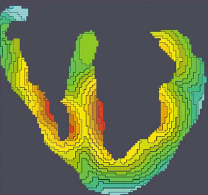IEEE Transactions on Biomedical Engineering 51(8):1319-1329, 2004.
context
This paper describes the monodomain version of our model. It was one of the first reaction-diffusion models of the entire human heart, and our first model to use a parallel computer. The model anatomy was the same as in the Lorange-Gulrajani model, only the resolution was much higher (a quarter millimeter). With its 12 million points, this model required 12 GB memory to work. Later work (actually published earlier, in 2003) reduced memory consumption to less than 5 GB, while replacing the Luo-Rudy model with the specifically human Bernus model. Later still, a bidomain version was developed, the mathematical definition of the fiber orientation was refined to make it suitable for bidomain simulations, and we switched to the more recent TNNP model for the human ventricular myocyte.
As an application of this model, an estimate was made of how much tissue had to have an abnormally short action potential duration in order to cause detectable changes in the body-surface QRST integral map. Depending on the site in the ventricles, 0.35 to 3% affected myocardium could be detected using difference maps. Much more would be needed to cause changes that would be visible in the ECG traces or in the QRST integral map itself.
other versions
abstract/full paper in PDF: doi:10.1109/TBME.2004.827934
corresponding author
This work was directed by Dr Ramesh Gulrajani. Because Dr Gulrajani died in March 2004, Mark Potse acts as corresponding author.abstract
The simulation of the propagation of electrical activity in a membrane-based realistic-geometry computer model of the ventricles of the human heart, using the governing monodomain reaction-diffusion equation, is described. Each model point is represented by the phase 1 Luo-Rudy membrane model, modified to represent human action potentials. A separate longer duration action potential was used for the M cells found in the ventricular midwall. Cardiac fiber rotation across the ventricular wall was implemented via an analytic equation, resulting in a spatially varying anisotropic conductivity tensor and, consequently, anisotropic propagation. Since the model comprises approximately 12.5 million points, parallel processing on a multiprocessor computer was used to cut down on simulation time. The simulation of normal activation as well as that of ectopic beats is described. The hypothesis that in situ electrotonic coupling in the myocardium can diminish the gradients of action-potential duration across the ventricular wall was also verified in the model simulations. Finally, the sensitivity of QRST integral maps to local alterations in action-potential duration was investigated.
funding
This work was supported by the Natural Sciences and Engineering Research Council of Canada. The work of M.-C. Trudel was supported by la Fondation J.A. de Sève and by FCAR, Québec, The work of M. Potse was supported by FCAR, Québec, and by the Netherlands Organization for Scientific Research (NWO).
